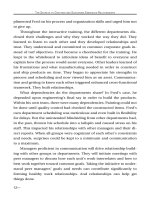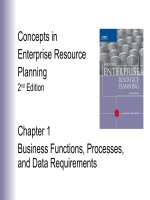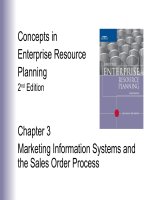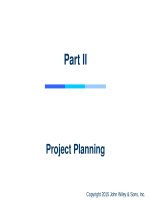Lecture Communication skill: Chapter 4 - Tracey Bretag, Joanna Crossman, Sarbari Bordia
Bạn đang xem bản rút gọn của tài liệu. Xem và tải ngay bản đầy đủ của tài liệu tại đây (381.17 KB, 60 trang )
Chapter 4
Academic conventions:
referencing and
avoiding plagiarism
Copyright 2009 McGraw-Hill Australia Pty Ltd
PPTs t/a Communication Skills, by Bretag, Crossman and Bordia
1
4-1
Learning objectives
On completion of this chapter students will
know how to:
• understand the ethical underpinnings of
academic scholarship and research in the
Australian/New Zealand context
• value the integral nature of referencing for
all academic work
• be able to use summarising, paraphrasing
and quoting in the development of an
academic research paper
Copyright 2009 McGraw-Hill Australia Pty Ltd
PPTs t/a Communication Skills, by Bretag, Crossman and Bordia
2
4-2
Learning objectives (cont.)
• understand the need to incorporate their
‘voice’ in academic argument
• be able to use connecting words and
reporting verbs appropriately
• have the skills to use both the first and the
third person in academic writing, depending
on course requirements
• appreciate the importance of establishing
good administrative systems for note-taking
and referencing.
Copyright 2009 McGraw-Hill Australia Pty Ltd
PPTs t/a Communication Skills, by Bretag, Crossman and Bordia
3
4-3
Educational integrity
• Educational integrity is based on the
premise that students and teachers in any
learning institution will adhere to honest
methods of teaching, learning and
assessment even when they are faced with
adverse or stressful situations.
Copyright 2009 McGraw-Hill Australia Pty Ltd
PPTs t/a Communication Skills, by Bretag, Crossman and Bordia
4
4-4
Educational integrity (cont.)
• Five major tenets of educational integrity:
–
–
–
–
–
honesty
trust
fairness
respect
responsibility (www.academicintegrity.org/)
• Students need to take responsibility for their
education by:
–
–
–
–
preparing for class, assignments and exams
avoiding cheating
referencing sources appropriately
refraining from any activities that will compromise
the integrity of their learning experience.
Copyright 2009 McGraw-Hill Australia Pty Ltd
PPTs t/a Communication Skills, by Bretag, Crossman and Bordia
5
4-5
Why study at university?
• The aim of studying in a university setting is
not to acquire a degree by any means
possible but to apply the knowledge we gain
in prospective jobs or our life in general.
• Any degree is partly meant to benefit the
individual who acquired it and partly meant
to benefit the society in which this individual
will work.
Copyright 2009 McGraw-Hill Australia Pty Ltd
PPTs t/a Communication Skills, by Bretag, Crossman and Bordia
6
4-6
Importance of referencing
• The first step towards achieving educational
integrity is learning to reference correctly.
• Referencing enhances your writing and
helps the reader by:
–
–
–
–
showing the breadth of your research
strengthening your academic argument
showing the reader your source of information
allowing the reader to consult and verify your
sources independently.
Copyright 2009 McGraw-Hill Australia Pty Ltd
PPTs t/a Communication Skills, by Bretag, Crossman and Bordia
7
4-7
Using references
• In an academic record references must be
provided whenever you use someone’s
ideas, opinions or words. That is, when you:
–
–
–
–
‘quote’ (use their exact words)
copy (use graphs, figures, tables)
paraphrase (use their idea in your own words)
summarise (give a brief account of their ideas).
Copyright 2009 McGraw-Hill Australia Pty Ltd
PPTs t/a Communication Skills, by Bretag, Crossman and Bordia
8
4-8
Activity 1
• Complete the ‘Using sources’ quiz on p. 63
of your textbook.
Copyright 2009 McGraw-Hill Australia Pty Ltd
PPTs t/a Communication Skills, by Bretag, Crossman and Bordia
9
4-9
The ‘blue chair theory’
Copyright 2009 McGraw-Hill Australia Pty Ltd
PPTs t/a Communication Skills, by Bretag, Crossman and Bordia
10
4-10
Harvard referencing
• Keep a copy of the referencing guide with
you (see Appendix 1 online) and check it
constantly when you are organising the
references for any assignment.
• There are two main parts to the author-date
system:
– in-text reference: acknowledges the information
used in the text
– reference list: lists all the sources cited in the
text.
Copyright 2009 McGraw-Hill Australia Pty Ltd
PPTs t/a Communication Skills, by Bretag, Crossman and Bordia
11
4-11
Harvard referencing (cont.)
• To acknowledge a source within the text of
an assignment or report, state the following:
– author’s family name
– year of publication
– page numbers (especially when you quote,
paraphrase or copy).
Copyright 2009 McGraw-Hill Australia Pty Ltd
PPTs t/a Communication Skills, by Bretag, Crossman and Bordia
12
4-12
In-text referencing
There are two ways of citing references:
• Author-prominent
– Gives prominence to the author by using the
author’s name as part of the sentence, with the
date and page number in brackets
– e.g. Smith (1992, p. 5) has argued that ‘the relative
seriousness of the two kinds of errors differs from
situation to situation’.
• Information-prominent
– Gives prominence to the information, with all the
details in brackets
– e.g. It has been argued that ‘the relative
seriousness of the two kinds of errors differs from
situation to situation’ (Smith 1992, p. 5).
Copyright 2009 McGraw-Hill Australia Pty Ltd
PPTs t/a Communication Skills, by Bretag, Crossman and Bordia
13
4-13
Page numbers
• Page numbers are one of the three
‘must-dos’ of the author-date system.
• Page numbers must be used whenever you
quote, copy, paraphrase or summarise an
idea from a particular page or pages.
• Note: Web pages do not have page
numbers.
Copyright 2009 McGraw-Hill Australia Pty Ltd
PPTs t/a Communication Skills, by Bretag, Crossman and Bordia
14
4-14
Referencing broad ideas
• You do not have to give the page number if
you have summarised a large portion of an
author’s work or if the idea is a general one
gleaned from a large work.
Copyright 2009 McGraw-Hill Australia Pty Ltd
PPTs t/a Communication Skills, by Bretag, Crossman and Bordia
15
4-15
Referencing online sources
• In-text references do not include the URL.
Use the same principles (author, date, page)
that you use for other in-text references.
– E.g. One researcher has suggested that new
technology will radically alter tertiary education
(Brown 1995).
– N.B. A page number is not usually available for
online documents. In this case, simply state the
author (or the organisation) and the date. Give the
full URL in the reference list. It is equivalent to a
page number.
Copyright 2009 McGraw-Hill Australia Pty Ltd
PPTs t/a Communication Skills, by Bretag, Crossman and Bordia
16
4-16
Referencing online sources
(cont.)
• If a Web page has no author, use the
sponsoring (or publishing) body.
– E.g. The Commonwealth Scientific and Industrial
Research Organisation employs 6500 staff at
Australian and international locations (CSIRO
2003).
• If there is no author or organisation use the
title of the web page and the date in-text.
Copyright 2009 McGraw-Hill Australia Pty Ltd
PPTs t/a Communication Skills, by Bretag, Crossman and Bordia
17
4-17
Reference list
• The reference list is arranged:
–
–
–
–
alphabetically
at the end of the essay, article or report
on a separate page
only with references that have been referred to in
your work (not everything you have read on the
topic)
– using consistent punctuation and layout (see
Appendix 1).
Copyright 2009 McGraw-Hill Australia Pty Ltd
PPTs t/a Communication Skills, by Bretag, Crossman and Bordia
18
4-18
Listing books
• Include the following information in this
order:
–
–
–
–
author’s surname and initials
year of publication
publisher
place of publishing
• e.g. Rayner, K. & Pollatsek, A. 1989, The Psychology
of Reading, Prentice-Hall, New Jersey.
Copyright 2009 McGraw-Hill Australia Pty Ltd
PPTs t/a Communication Skills, by Bretag, Crossman and Bordia
19
4-19
Listing journal articles
• Include the following information in order:
–
–
–
–
–
–
–
author’s surname and initials
year of publication
title of article (in quotation marks)
title of journal (in italics)
volume number (if applicable)
issue number (if applicable)
page number(s).
Copyright 2009 McGraw-Hill Australia Pty Ltd
PPTs t/a Communication Skills, by Bretag, Crossman and Bordia
20
4-20
Listing online sources
• Include the following information in order:
– the author (editor or compiler) (if there is no
author use the publishing or sponsoring body)
– date (of creation or most recent update)
– title of the Web document (this may be in italics
or in ‘quote marks’)
– publishing or sponsoring body (do not use this
twice if you have used this as ‘author’)
– date accessed
– the FULL URL link.
Copyright 2009 McGraw-Hill Australia Pty Ltd
PPTs t/a Communication Skills, by Bretag, Crossman and Bordia
21
4-21
Important
• It is not enough to simply add a reference
list to the end of an essay or report.
• Do not give one reference at the end of a
paragraph!
• All references in the list must match your intext references.
• Double-check that you have used a
consistent and correct punctuation style in
the reference list.
Copyright 2009 McGraw-Hill Australia Pty Ltd
PPTs t/a Communication Skills, by Bretag, Crossman and Bordia
22
4-22
Activity 2
• Complete the ‘Referencing’ quiz on pp. 69–
70 of your textbook.
Copyright 2009 McGraw-Hill Australia Pty Ltd
PPTs t/a Communication Skills, by Bretag, Crossman and Bordia
23
4-23
What is plagiarism?
• Plagiarism is to take someone else’s words
or ideas and present them as your own. For
example:
– using someone else’s ideas or words without
referencing
– using a direct quote without referencing (note:
you need to show a quote by using ‘quotation
marks’)
– copying another student’s work and submitting it
as your own
– submitting another student’s work in whole or
in part.
Copyright 2009 McGraw-Hill Australia Pty Ltd
PPTs t/a Communication Skills, by Bretag, Crossman and Bordia
24
4-24
What is plagiarism? (cont.)
– submitting work which has been written by
someone else on your behalf
– using lecture/tutorial notes without referencing
(including lecture notes from another
course/institution)
– paraphrasing work by only changing a few words
(you still need to give the full reference for
paraphrases).
Copyright 2009 McGraw-Hill Australia Pty Ltd
PPTs t/a Communication Skills, by Bretag, Crossman and Bordia
25
4-25









